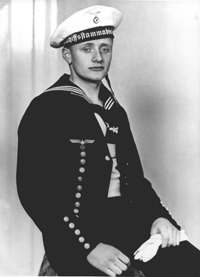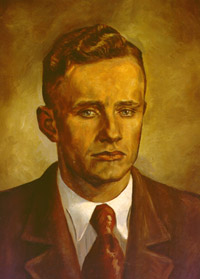|


Germany (1921)
Sources:
Irene Förster (niece and godchild) / Leipzig
Bundesarchiv Abteilung PA
|
Paul Karl Weise — called Karli by his family — was born on July 24, 1920 in the town of Lindenthal, northwest of Leipzig, as the youngest of five brothers. He was the son of Frederike, née Göhre, and Rudolf Weise. The family lived in an apartment at Ludendorffstrasse 20. This was part of a railway workers' settlement in the west of Lindenthal that had been built around the turn of the century. The settlement was a large building complex made up of three-story rows of apartment buildings with multi-family apartments, which stretched along Ludendorffstrasse and several streets branching off from it. The rows of houses were light-colored plastered and had red roofs. They offered the children of the neighborhood open and wide courtyards and adjacent green areas for playing. At that time, around 4,500 people lived in Lindenthal on the outskirts of Leipzig. Karl Weise grew up here with his siblings Rudi, Richard, Walter and Kurt. He attended school in Lindenthal and then did an apprenticeship as a butcher in Clausthal-Zellerfeld in the Harz Mountains. Why he did his apprenticeship around 200 km away is not known.
|
|
|
1 A portrait photo taken before the war (see below) shows him in uniform during his first basic training and supports this thesis.
|
In 1938 or 39, Karl Weise volunteered for the Navy during peacetime. According to information from his personnel file in the Federal Archives, his service began on October 1, 1939 with basic training at the 11th Schiffsstammabteilung in Stralsund. A postcard from the town, written to his parents and siblings, however, testifies to an earlier stay in Stralsund in April 1939. Karl Weise wrote this postcard from the hospital. The cough had almost completely gone and he no longer felt anything, he said. Perhaps he would be out soon, he continued, and sent his best wishes to his parents and brothers. He was therefore probably called up on April 1, 19391, but then fell ill and had to go to the hospital while the other recruits continued their basic training. Karl Weise, on the other hand, was probably sent home to recover after his release from the hospital, before coming back at the beginning of October 1939. In the meantime, the war had started. He now had to repeat the basic training he had interrupted. It was still full and lasted three months. The recruits most likely stayed in the barracks over Christmas and New Year, or went ashore in Stralsund. For them, it was probably the first Christmas away from their families. Shortly after the start of the new year, they were assigned to positions. Karl Weise was assigned to the ship's artillery school in Saßnitz. His specialist training began there. In an eleven-week course, he received intensive training in rangefinders. The optical devices were used to observe air and sea targets and measure their position and distance in order to calculate firing values for artillery or anti-aircraft defense based on the measured data. Karl Weise then received further, primarily practical, training at the Anti-Aircraft and Coastal Artillery School in Swinemünde. During this time, on June 16, 1940, he took over the sponsorship of his niece Irene Weise, who tells us about him here. She only knows her uncle "Karli " from her family's stories, as she was too young to remember him.
 On July 2nd, 1940, Karl Weise was ordered to the battleship Bismarck for construction instruction. He traveled to Hamburg by train. There he found his ship at the outfitting quay of the Blohm & Voss shipyard. Shipyard workers were still carrying out final work on the ship so that it could be handed over to the Navy as quickly as possible. The future crew members, who had already been ordered to Hamburg, threw themselves into the hustle and bustle and were led through the ship in small groups. During their explorations, they get to know the ship thoroughly and, for example, trace cables that might later be hidden by built-in features. For construction instruction, they lived on barges. During their time in Hamburg, Karl Weise had his portrait taken in a photo studio in Hamburg-Altona and sent the photo to his parents. Seven and a half weeks after his command, he and his division reported to the upper deck for the ceremonial commissioning of the Bismarck. He was now able to move into his accommodation deck on the Bismarck. In mid-September 1940, the ship set sail and headed for the Baltic Sea. For Karl Weise and many of the other sailors on board, it was their first sea voyage. When bad weather came along on the journey from Kiel through the Baltic Sea to Gotenhafen, many of them had to struggle with seasickness. Over the next few weeks, the new ship was intensively tested and the crew trained in the Bay of Danzig. Karl Weise apparently still had some shortcomings, so he was assigned to a three-week refresher course at the beginning of December 1940. He completed the rangefinder course I at the 3rd department of the naval artillery school in Kiel. The course ended on December 20th. In the meantime, the Bismarck had moved back to Hamburg, where the remaining work was being carried out in the shipyard. It is not known whether he was sent on Christmas leave after his return like most of his comrades or whether he stayed on board over the holidays away from his family again.
On July 2nd, 1940, Karl Weise was ordered to the battleship Bismarck for construction instruction. He traveled to Hamburg by train. There he found his ship at the outfitting quay of the Blohm & Voss shipyard. Shipyard workers were still carrying out final work on the ship so that it could be handed over to the Navy as quickly as possible. The future crew members, who had already been ordered to Hamburg, threw themselves into the hustle and bustle and were led through the ship in small groups. During their explorations, they get to know the ship thoroughly and, for example, trace cables that might later be hidden by built-in features. For construction instruction, they lived on barges. During their time in Hamburg, Karl Weise had his portrait taken in a photo studio in Hamburg-Altona and sent the photo to his parents. Seven and a half weeks after his command, he and his division reported to the upper deck for the ceremonial commissioning of the Bismarck. He was now able to move into his accommodation deck on the Bismarck. In mid-September 1940, the ship set sail and headed for the Baltic Sea. For Karl Weise and many of the other sailors on board, it was their first sea voyage. When bad weather came along on the journey from Kiel through the Baltic Sea to Gotenhafen, many of them had to struggle with seasickness. Over the next few weeks, the new ship was intensively tested and the crew trained in the Bay of Danzig. Karl Weise apparently still had some shortcomings, so he was assigned to a three-week refresher course at the beginning of December 1940. He completed the rangefinder course I at the 3rd department of the naval artillery school in Kiel. The course ended on December 20th. In the meantime, the Bismarck had moved back to Hamburg, where the remaining work was being carried out in the shipyard. It is not known whether he was sent on Christmas leave after his return like most of his comrades or whether he stayed on board over the holidays away from his family again.
 After a long delay, combat training was continued in the Bay of Danzig in the spring of 1941 until the end of April when the goal of all efforts was finally achieved: combat readiness. In mid-May 1941, Karl Weise finally set sail on his first mission. Unfortunately, it is not known exactly where on board he served as a rangefinder. He did not survive the sinking of his ship a few days later. Karl Weise was 20 years old at the time of his death.
After a long delay, combat training was continued in the Bay of Danzig in the spring of 1941 until the end of April when the goal of all efforts was finally achieved: combat readiness. In mid-May 1941, Karl Weise finally set sail on his first mission. Unfortunately, it is not known exactly where on board he served as a rangefinder. He did not survive the sinking of his ship a few days later. Karl Weise was 20 years old at the time of his death.
The family received a letter from the Navy informing them that their son had been on the battleship Bismarck and that he had been missing since the sinking because his remains had not been found. It was difficult for the family to accept the loss under these circumstances. A whole year passed before the death could be officially recorded.
|
|